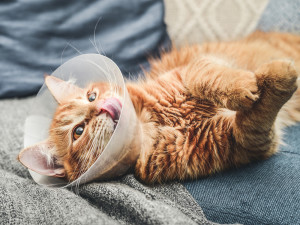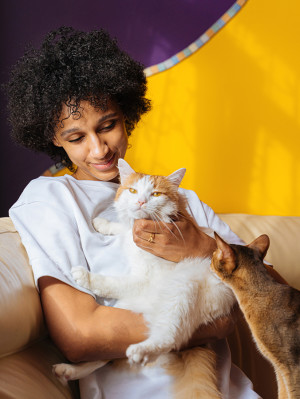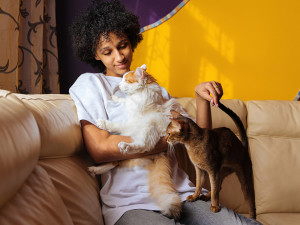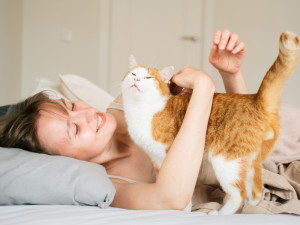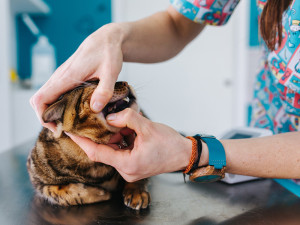Male vs Female Cats: What Are the Differences?
There’s more to it than you might think
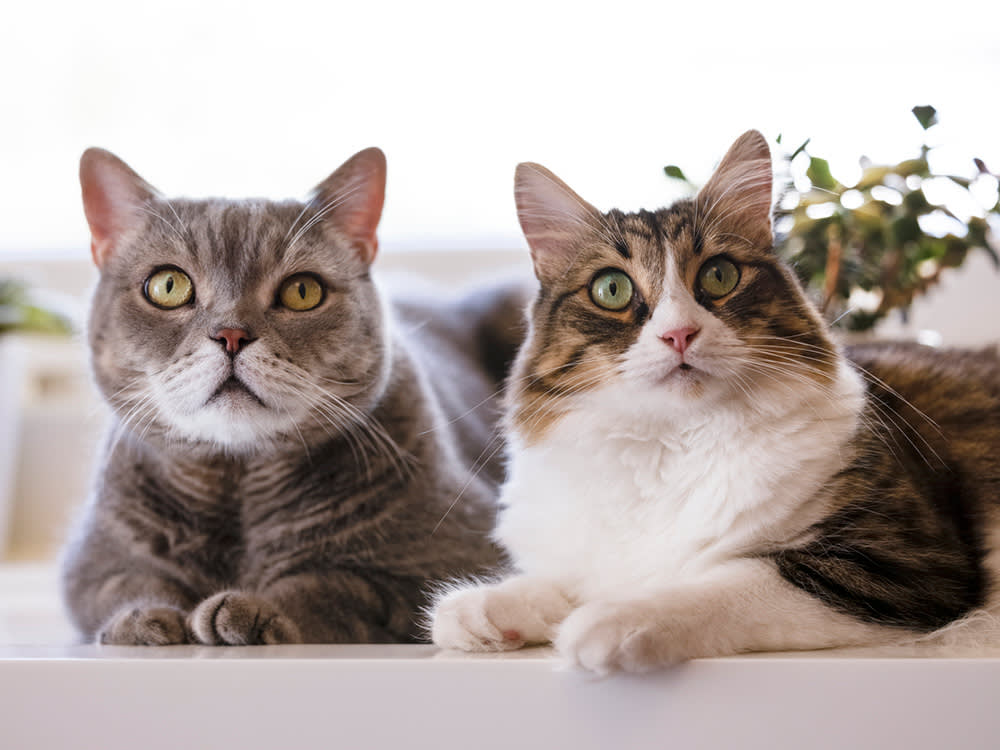
Share Article
Male and female cats have some physical and behavioural differences, but the most important factor is the individual cat‘s personality. When considering cat adoptionopens in a new tab (and you should), you may wonder about the differences between genders. The common perception is that males are more loving and females are aloof. Males may also mark territory by spraying urine, while female cats may be more vocal. Let’s get into the differences between male and female cats
What are the differences between a male and female cat?
Physically, males are larger and heavier with more prominent heads. Behaviourally, male cats are known to be more affectionate, but are also more territorial. Female cats tend to be calmer, but less open to strangers. The differences between male and female cats are more noticeable in intact cats, so make sure your cat is spayed or neuteredopens in a new tab.

littleKin™ is Kinship’s home just for puppy and kitten parents. Bop over to check out expert advice, new pet tools, and special deals—all curated for your newest family member.
opens in a new tabWhat are the physical differences between male and female cats?
There are a few physical differences between male and female cats, and some are more obvious than others. The best way to differentiate male and female cats is by their external genitalia. Intact males will have testicles that are easily seen from a distance.
Differentiating between male and female kittens, or neutered male and adult females, involves a peek under the tail. The distance between the anus and penis in male cats is greater than the distance between the anus and vulva in female cats. The difference in proximity of genitalia to the anus, as well as differences in the size of the urethra contribute to certain health risks. A male cat’s longer and narrower urethra leaves him at risk for urethral obstruction. Female cats have a higher risk of developing urinary tract infectionsopens in a new tab.
Male cat versus female cat size can vary a good bit, but their breed plays a big role as well. When comparing body weight overall, female cats tend to be smaller and lighter. Female cats also reach their mature body weight earlier in life (13 months of age ) than males (16 months of age). Breed differences are often a bigger factor in body size. You can expect the average female Maine Coon to be much larger than a svelte male Siamese.
Gender can also have an impact on male and female cats’ appearance. Intact male cats will have large, rounded heads with prominent jowls due to testosterone. These chubby cheeks will linger in male cats that are neutered after reaching maturity. Coat colour is also linked to sex. Most (but not all) orange tabby cats are male, and most (but not all) calico cats are female.
What are the behavioural differences between male and female cats?
Sex and reproductive status can impact cat behaviour. Keep in mind that behaviour and temperament can be very specific to each individual cat (who doesn‘t know a cat with bizarre quirks?) – but there are patterns.
When researchersopens in a new tab polled cat parents, they found that female cats tend to be more fearful and less social towards both people and other cats. Other surveys and anecdotal evidence suggest that male cats are more playful and active than females. All this may sound like an argument to only consider adopting male cats, so let’s tip the scales in the other direction. Male cats can be more territorial, leading to more fights and battle wounds, but neutering reduces this behaviour significantly. Male cats are also twice as likely to engage in urine marking than females. There is no difference in the trainabilityopens in a new tab of male and female cats. They may cooperate, but don’t hold your breath.
Are male or female cats more affectionate?
Male cats have a reputation for being more affectionate than female cats. But is there any data behind this claim? Are female cats more aggressive than male cats when it comes to interacting with people?
When researchersopens in a new tab at University of California, Davis investigated possible relationships between feline coat colour and aggression, they found tortoiseshell and calico cats, which are almost always female, to be among the most feisty. This study didn’t compare sexes, so definite conclusions can’t be drawn. Besides, people who spend enough time around cats can definitely vouch for the fact that some female cats are absolute love bugs and some male cats are total A-holes.
Research has also shown that, when it comes to a cat‘s level of affection, early handling, socialisation and genetics are likely far more significant than gender. Also, affection towards humans they know versus strangers can vary widely as many cats adopt a ‘no new friends’ approach to people. It makes more sense to consider each cat as an individual with a unique personality and temperament.
Are there differences between male and female cat‘s lifespan?
Female cats tend to live longer than male cats. Despite this statistic, lifestyle has a far greater impact on lifespanopens in a new tab than gender. Intact males tend to roam and fight, increasing their risk for injury and infection. Intact females are at higher risk for mammary cancer and uterine infections. Outdoor cats of either gender face more danger and have shorter life spans. Cats who are unvaccinatedopens in a new tab and don’t receive routine veterinary care also do not live as long.
What research has been done on male vs female cats?
Research that has identified the most conclusive difference between male and female cats primarily focuses on measurable data like body size, body weight and the frequency of specific diseases. These measurements help establish averages and disease risk factors. However, science can also be used to delve into some fascinating questions. This is how we get cool cat facts.
A studyopens in a new tab conducted by professors at Queen’s University in Belfast investigated laterality in cats. Basically, are cats left-pawed or right-pawed? They found that when it comes to reaching for food, stepping over objects and stepping down, males showed a preference for their left paws and females favoured their right.
When given access to a running wheel, researchersopens in a new tab found an increase in physical activity in female cats, with no change in the activity level of male cats.
Another studyopens in a new tab compared responsiveness of male and female cats to kitten cries. Female cats were observed to be more responsive and showed more urgency than male cats. There was no difference between females that previously raised kittens and those that had not.
Should you get a male or female cat?
When deciding between adopting a male or female cat, there’s no right or wrong answer. A male cat may be more rambunctious and affectionate, but may also spray urine in your home. A female cat may be more quiet and independent, but may choose you as the person they trust. There are no guarantees, so it‘s best to just adopt the cat who clicks with youopens in a new tab rather than looking for one of a specific gender.
Which combination of cats gets along better?
Regardless of gender, cats that grow up together are more likely to bondopens in a new tab than cats introduced as adults, but that doesn’t mean that adult cats can’t become friends. When introducing adult cats, those that have been spayed or neutered tend to get along much better than cats that are still intact. Hormones drive a lot of aggressive and undesirable behaviours.
In the wild, female cats form cooperative colonies to aid in caring for kittens, but this acceptance isn’t automatically extended to every cat. Cats of either gender are capable of being the best of friends or bitterest of enemies. If you’re considering adding another cat to the mix, just be sure to make a proper introduction.
While gender does play a role in a cat’s size and demeanour, cats are individuals, and won’t have a specific personality based on the gender. Nature, nurture and mystery sauce make each cat unique.
Frequently asked questions
Do male cats spray more than females?
Male cats urine spray more commonly than female cats. While neutering helps decrease the incidence of urine spraying, it’s not guaranteed to eliminate the behaviour. While less common, female cats can also urine spray, a behaviour more commonly seen when they are in heat.
Should I spay or neuter my cat regardless of gender?
All cats should be spayed or neutered regardless of gender. Spaying and neutering help decrease behavioural issues, reduce risk of certain diseases and increase lifespan.
Is there a difference in grooming needs between male and female cats?
Long-haired cats of either sex will require more grooming than short-haired cats. This may be more important in female, long-haired cats to reduce the risk of urinary tract infection.
References:
Reliability and Validity of Seven Feline Behavior and Personality Traitsopens in a new tab
A pilot study of the body weight of pure-bred client-owned adult catsopens in a new tab
The Relationship Between Coat Color and Aggressive Behaviors in the Domestic Catopens in a new tab
Growth Curve and Energy Intake in Male and Female Catsopens in a new tab
Life expectancy tables for dogs and cats derived from clinical dataopens in a new tab
Lateralization of spontaneous behaviours in the domestic cat, Felis silvestrisopens in a new tab

Dr. Alycia Washington, DVM, MS
Alycia Washington, DVM, is a small animal emergency veterinarian based in North Carolina. She works as a relief veterinarianopens in a new tab and provides services to numerous emergency and specialty hospitals. Dr. Washington is also a children’s book author and freelance writer with a focus on veterinary medicine. She has a special fondness for turtles, honey bees, and penguins — none of which she treats. In her free time, Dr. Washington enjoys travel, good food, and good enough coffee.
Related articles
![]()
Cutting Cat Nails Is Hard, Is This Unusual Viral Hack The Answer?
We asked a behaviourist if this content creator’s approach to cutting his kitten’s nails is something you can try at home
![Woman laying on her bed while hugging her cat]() opens in a new tab
opens in a new tabWhy Does My Cat Wake Me Up At the Crack of Dawn?
Here’s what to do when your cat starts pawing at your face before the sun has even come up
![brown cat in grass]() opens in a new tab
opens in a new tabHairballs: A Tangled Web
What to do when your cat hawks one up
![Curly afro woman stroking her bonded cats on the couch in living room]() opens in a new tab
opens in a new tabShould I Adopt a Bonded Pair?
Some besties are inseparable, and that’s not always a bad thing
![Young female veterinarian in her consulting room performing a medical examination on a pet]() opens in a new tab
opens in a new tabWhat You Need to Know About Cat Mouth Ulcers
How to spot, diagnose and treat the painful lesions – whether cancerous or non-cancerous
![A wheaten terrier getting a haircut to remove the hair from over his eyes]() opens in a new tab
opens in a new tab9 of the Best Dog Grooming Products
Tools to keep your pet looking so fresh and so clean, from bamboo hair brushes to biodegradable wipes
